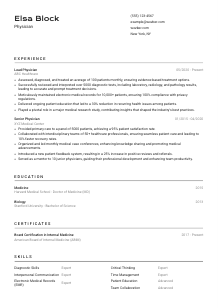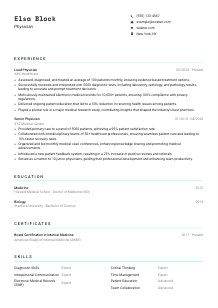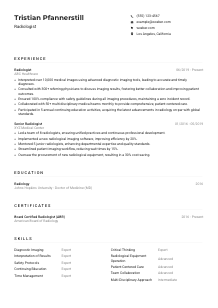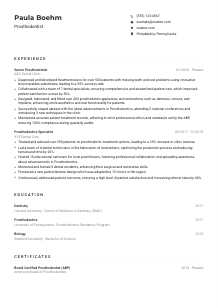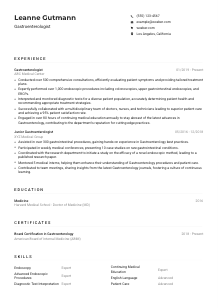Physician Resume Example
Healing patients, but your resume feels a bit under the weather? Discover this Physician resume example, written using Wozber free resume builder. See how effortlessly you can prescribe your medical expertise to align with job criteria, making sure your career stays in the peak of health!
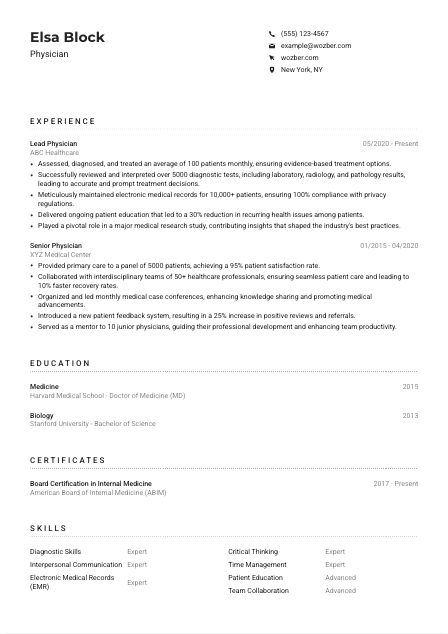
How to write a Physician resume?
Hello, future medical maestro! In the realm of healthcare, where precision and compassion intertwine, your resume is a gateway to showcasing your healing touch and clinical acumen. Guided by Wozber, this journey will sculpt a resume that resonates with the heartbeat of your desired role.
Embrace the opportunity to communicate your dedication to medicine with a resume that reflects both your expertise and humanity. Let's navigate through the art of crafting a resume that aligns seamlessly with the Physician position, ensuring your professional narrative shines.
Personal Details
Your journey begins with the perfect annotation of your professional persona. Believe it or not, the doorway to resonating with your potential employer starts right at your personal details. Layered with finesse, this section is more than just an introduction—it's your first step in aligning with the heartbeat of the job. Let's delve into crafting this section with the precision of a skilled Physician.
1. Name with Authority
Start strong with your name, your personal brand. Make sure it's easily noticeable, serving as the anchor of your professional identity. Just as you'd confidently introduce yourself in a clinical setting, let your name on the resume be clear and pronounced.
2. Professional Title Precision
Directly beneath your name, specify your professional title. Using "Physician" anchors your expertise, mirroring the job description and aligning immediately with the role's expectations. This strategic placement introduces your specialty right off the bat.
3. Contact Essentials
Accuracy in your contact details is key. Include a phone number and a professional email—think of it as presenting your pager number and hospital ID. This is how they'll reach you for the next steps, so double-check for accuracy. Remember, it's firstname.lastname@email.com for a clean, professional look.
4. Localizing Your Practice
"Must be located in or willing to relocate to New York, NY." If this fits you like a glove, showcase it. Including New York, NY in your location details matches you to one of the role's essentials, facilitating a smoother journey towards candidacy without the hurdles of relocation concerns.
5. Web Presence
In today's digital age, a LinkedIn profile or a professional website showcasing your publications, certifications, or contributions to medical blogs can amplify your credibility. Ensure it's updated and reflects your resume's tale.
Takeaway
The Personal Details section is your first handshake with your potential employer—make it firm, confident, and reflective of your professional identity. Be accurate, relevant, and remember, this is where the narrative of your medical journey begins. Let's set the stage for a compelling and aligned introduction that resonates with your desired Physician role.





Experience
The heart of your resume thrives in your experience section. This is where you display your clinical prowess, your leadership in healthcare teams, and your commitment to patient care. Tailoring this section to mirror the job requirements is akin to crafting a patient care plan—thoughtful, personalized, and effective. Let's delve into how your experience can narrate the story of a physician who's not just qualified, but uniquely suited for the role.
- Assessed, diagnosed, and treated an average of 100 patients monthly, ensuring evidence‑based treatment options.
- Successfully reviewed and interpreted over 5000 diagnostic tests, including laboratory, radiology, and pathology results, leading to accurate and prompt treatment decisions.
- Meticulously maintained electronic medical records for 10,000+ patients, ensuring 100% compliance with privacy regulations.
- Delivered ongoing patient education that led to a 30% reduction in recurring health issues among patients.
- Played a pivotal role in a major medical research study, contributing insights that shaped the industry's best practices.
- Provided primary care to a panel of 5000 patients, achieving a 95% patient satisfaction rate.
- Collaborated with interdisciplinary teams of 50+ healthcare professionals, ensuring seamless patient care and leading to 10% faster recovery rates.
- Organized and led monthly medical case conferences, enhancing knowledge sharing and promoting medical advancements.
- Introduced a new patient feedback system, resulting in a 25% increase in positive reviews and referrals.
- Served as a mentor to 10 junior physicians, guiding their professional development and enhancing team productivity.
1. Job Requirements Breakdown
Dissect the job description as you would a complex case. For each requirement, think of how your past roles align. Did you "assess, diagnose, and treat patients"? How many diagnostic tests have you reviewed? Your roles are your symptoms; diagnose them to match the job's needs.
2. Structure with Precision
Present your experiences in a reverse-chronological order, starting with your most recent position. Ensure each entry includes your title (e.g., "Lead Physician"), the facility's name, and the tenure of your appointment.
3. Craft Compelling Narratives
Transform your responsibilities and achievements into stories of impact. Did you lead a successful research study? Reduce patient readmissions through innovative care plans? Quantify your successes and frame them in action, showing your proactive approach in clinical settings.
4. Numerical Narratives
Quantification adds weight to your achievements. If you treated an average of 100 patients monthly, say so. Reviewing over 5000 diagnostic tests demonstrates your analytical prowess. Numbers provide tangible proof of your contributions and expertise.
5. Relevance is Key
Filter your experiences through the lens of the role. Non-relevant experiences, while possibly interesting, can distract from your core narrative. Keep the focus on clinical achievements and contributions that resonate with the Physician role.
Takeaway
Your experience section is the evidence-based narrative of your clinical journey. Tailor each entry to reflect how perfectly you fit the Physician role, quantifying your impact and emphasizing relevant achievements. Your resume should read like a patient case where you're the solution—precise, impactful, and undeniably effective. Now, let's ready the next section to further distinguish you.
Education
In the world of medicine, your education is the bedrock of your expertise. Here, you're not just listing degrees; you're underscoring the rigor and dedication of your training. Aligning this section with the job's prerequisites exemplifies your qualification and preparation for the challenges of the Physician role. Let's dissect how to refine your education section with the analytical eye of a diagnostician.
1. Key Requirements Identification
Begin with the end in mind by pinpointing what the job listing explicitly requests. For a «Medical degree (MD or DO) with a minimum of 7 years of post-graduate training», ensure these are prominently listed in your resume, laying the groundwork for your qualifications.
2. Structuring with Clarity
Maintain a straightforward layout: specify your field of study, degree earned, followed by the institution and graduation date. This clarity allows the hiring manager to swiftly verify your qualifications against their needs.
3. Degree Specificity
Highlight the medical degree and any specialization to mirror the job specifics. For instance, if you are "Board certified in Internal Medicine", list it. This not only showcases your qualifications but also your specialization, aligning with the job's focus.
4. Relevant Coursework and Honors
Though not always necessary, mentioning relevant coursework, honors, or involvement in university-led research projects can illustrate early signs of your commitment and passion for medicine. Use discretion based on how directly these experiences relate to the job at hand.
5. Continuing Education
Medicine is an ever-evolving field. Include any recent courses or certifications that demonstrate your commitment to staying at the forefront of medical advancements. This shows not only a dedication to your craft but also a proactive approach to patient care.
Takeaway
Your education section should reflect the foundation of your medical expertise and your journey through rigorous training. It's about more than degrees; it's a testimony to your dedication and readiness to face the challenges of the Physician role. With careful crafting, your education can shine as a pillar of your qualification, positioning you as a prime candidate ready to advance in the field of medicine.
Certificates
In a profession where ongoing education is not just valued but vital, your certificate section is a testament to your dedication to excellence in patient care. Here, you highlight your commitment to professional development and staying abreast with the medical field's advancements. Let's navigate through selecting and presenting your certifications to underscore your qualifications for the Physician role.
1. Identify Key Certifications
Refer back to the job description. Certification requirements like a "Valid state medical license» are your cue to highlight these credentials prominently in your resume. This showcases not only your legal qualification for the role but also your compliance with industry standards.
2. Certificate Selection
Prioritize certificates that align most closely with the job specifications. The "Board Certification in Internal Medicine" directly mirrors the job's call for board-certified candidates, emphasizing your specialized expertise and commitment to the field.
3. Transparency with Dates
Detailing the acquisition or expiration dates of your certificates adds a layer of trust and relevancy. It informs employers of your current qualifications and your proactive stance in maintaining them. This temporal context is vital, particularly in fields where certifications require regular renewal.
4. Continuous Learning
Medicine's constant evolution demands that you stay updated with the latest practices and breakthroughs. Highlight recent or ongoing certifications to demonstrate your engagement with continuous education, reinforcing your commitment to providing the best care.
Takeaway
Your certificates are the badges of honor in your relentless pursuit of clinical excellence and patient care improvement. By carefully selecting and presenting these accolades, your resume doesn't just list qualifications—it narrates your ongoing journey in enhancing your medical prowess. These testimonials to your dedication will resonate strongly with hiring managers, aligning perfectly with the expectations for a Physician role.
Skills
In the realm of healthcare, your skills section is where you showcase your clinical expertise and your ability to navigate the complex dynamics of patient care. This portion of your resume is a curated collection of your professional competencies, demonstrating your readiness to take on the Physician role. Here's how to tailor your skills to speak directly to the needs and challenges of the position, shining a spotlight on your unique capabilities.
1. Match Job Description
Start by meticulously analyzing the job description. Listing "Diagnostic Skills" and "Interpersonal Communication" as expertise reflects the job's demand for excellent diagnostic abilities and the need to effectively collaborate with patients and healthcare teams. This direct correlation underscores your suitability for the role.
2. Highlight Relevant Skills
Choose skills that directly match the job's requirements, prioritizing those that demonstrate your competence in areas critical to the role. For instance, "Electronic Medical Records (EMR)" expertise is invaluable in today's healthcare landscape, showcasing your adaptability and attention to compliance.
3. Concise and Targeted
Resist the urge to list every skill you possess. A focused selection that aligns with the job description will capture the hiring manager's attention more effectively. This curated approach serves as a beacon, guiding the employer through your most relevant professional attributes.
Takeaway
Your skills section is a powerful testament to your proficiency and readiness for the Physician role. By carefully aligning your skills with the job requirements, you demonstrate a targeted understanding of what the position demands. Let this part of your resume be the mirror reflecting your adequacy and potential to excel in the role. Your expertise, presented with precision, will undoubtedly catch the eye of any hiring manager.
Languages
In an increasingly globalized healthcare environment, linguistic versatility can bridge cultural gaps and enhance patient care. The ability to communicate effectively in multiple languages can be a significant asset, especially in diverse communities. Here's how you can reflect linguistic skills in your resume, presenting them as invaluable tools for effective communication in the medical field.
1. Job Description Review
Begin with the job posting. Noting the essential requirement for "Ability to speak and write in English" immediately signals the importance of confirming your proficiency in English as a baseline requirement, while also prompting you to consider other languages you can speak.
2. Prioritize Critical Languages
If English is a requirement, list it prominently along with your level of fluency. This directly addresses a key qualification, assuring the hiring committee of your ability to communicate effectively in the primary language of operation.
3. Include Additional Languages
For Physicians, the ability to communicate in languages beyond English can enhance patient rapport and trust, especially in communities with diverse linguistic backgrounds. Include these additional languages to showcase your versatility and empathy in patient care.
4. Accuracy in Proficiency Levels
Be honest about your level of proficiency in each language. This reveals not only your linguistic capabilities but also your integrity, an essential attribute in the medical profession. Whether you're "Fluent" or at an "Intermediate" level, clarity here can set realistic expectations.
5. Evaluate the Role's Linguistic Needs
Consider the role's location and the patient demographics you'll serve. In a cosmopolitan area like New York, NY, the diversity of languages spoken can turn your multilingual skills into a vital asset, enhancing patient care and understanding.
Takeaway
Your ability to communicate in multiple languages is more than just a line on your resume; it's a testament to your capacity to connect with and care for patients across cultural boundaries. Highlighting these skills demonstrates your preparedness to meet the diverse needs of your patient population, casting you as a compassionate and adaptable candidate for the Physician role. Your linguistic adaptability is a bridge to better care, a quality that should be proudly showcased.
Summary
Your resume's summary serves as your professional handshake, offering a concise glimpse into your medical career and aspirations. It encapsulates your journey, expertise, and the unique value you bring to the Physician role. Here, you'll craft a narrative that aligns with the needs of your desired position, ensuring that your introduction sets the stage for the detailed excellence that follows in your resume.
1. Essence of the Job
First, soak in the essence of the job description to identify its core needs. For a Physician, it's about blending diagnostic acuity with compassionate patient care, tailoring treatments, and contributing to medical knowledge.
2. Introduce with Impact
Begin your summary by establishing your professional identity: "Physician with over 10 years of providing advanced medical care." This not only states your role but also underscores your extensive experience, setting the tone for the caliber of candidate you are.
3. Address Key Competencies
Weave in competencies that sync with the job's demands. Highlighting your "proven track record in accurately diagnosing and treating patients" directly answers the job description, while mentioning your leadership in "maintaining electronic medical records" showcases your adaptability and commitment to compliance.
4. Brief but Mighty
Your summary should be both captivating and succinct. Within 3-5 lines, you have to encapsulate your professional essence, drawing the hiring manager into your narrative while leaving them eager to learn more about your journey and accomplishments.
Takeaway
Consider your summary the prologue to your professional story—a snapshot of your career, expertise, and individuality as a Physician. This section is your chance to intrigue and assure the hiring manager that you're not just another candidate, but the candidate for the role. Craft it with the passion and precision you bring to patient care, and let it reflect the dedication and expertise that characterizes your medical career.
Launching Your Physician Journey
Congratulations on completing this comprehensive guide! With these insights, your resume is now a potent blend of professional wisdom and personal flair, fully equipped to navigate the competitive landscape of the medical field. Embrace this moment to refine each section, ensuring your resume is not just ATS-compliant but also a reflection of your unique journey in medicine. Your dedication to healing and patient care, mirrored through your crafted resume, is the cornerstone of your next big leap.
The path forward is clear; your next role awaits. Let your expertise, compassion, and commitment guide you towards a fulfilling career as a Physician. The world is in need of your talents—step forward with confidence.

- Medical degree (MD or DO) with a minimum of 7 years of post-graduate training in a medical specialty.
- Board certification or eligibility in the relevant medical specialty, as per common industry standards.
- Valid state medical license without any restrictions or history of disciplinary actions.
- Excellent diagnostic skills and the ability to provide evidence-based treatment options to patients.
- Strong interpersonal and communication skills to effectively collaborate with patients, families, and interdisciplinary healthcare teams.
- Ability to speak and write in English essential.
- Must be located in or willing to relocate to New York, NY.
- Assess, diagnose, and treat patients, prescribing medication or administering appropriate treatments when necessary.
- Review and interpret diagnostic tests, including laboratory, radiology, and pathology results.
- Maintain accurate medical records, documentation, and ensure compliance with privacy regulations.
- Provide ongoing patient education, preventive care, and follow-up support to patients.
- Participate in medical research studies, clinical trials, and staying updated on the latest best practices in the field.






